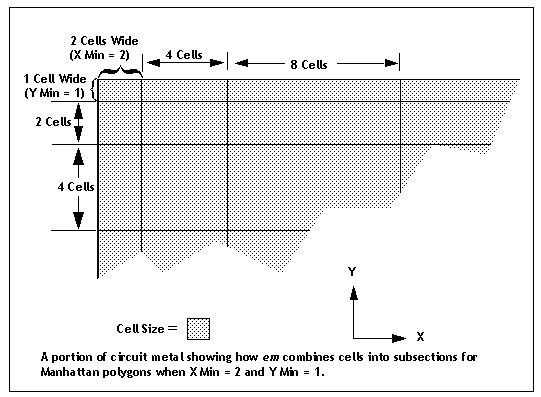On occasion, you may wish to change the default subsectioning for a given polygon. You can do this using the subsectioning parameters X Min, Y Min, X Max and Y Max.
Having the edge mesh option “on” is the default state for Sonnet projects; however, examining the case where edge mesh is “off” first makes understanding the concept easier. This part of the discussion only applies to Manhattan polygons, which is a polygon that has no diagonal edges. Turning edge mesh off for non-manhattan polygons has no effect.
For Manhattan polygons with edge mesh off, X Min and Y Min set the size of the edge subsections. By default, X Min and Y Min are 1. This means the edge subsections are 1 cell wide. When X Min is set to 2, the subsections along vertical edges are now 2 cells wide in the X direction (see the figure on page 38). This reduces the number of subsections and reduces the matrix size for a faster analysis. However, accuracy may also be reduced due to the coarser modeling of the current density near the structure edge or a discontinuity.

If X min or Y min are greater than your polygon size, em uses subsections as large as possible to fill the polygon.
NOTE: The subsection parameters, X Min, Y Min, X Max and Y Max are specified in cells (not mils, mm, microns, etc.). For example, X Min = 5 means that the minimum subsection size is 5 cells.
Although the X Min and Y Min parameters are very useful options, it is not a substitute for using a larger cell size. For example, a circuit with a cell size of 10 microns by 10 microns with X Min = 1 and Y Min =1 runs faster than the same circuit with a cell size of 5 microns by 5 microns with X Min = 2 and Y Min = 2. Even though the total number of subsections for each circuit may be the same, em must spend extra time calculating the value for each subsection for the circuit with the smaller cell size.